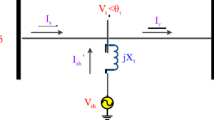Abstract
The integration of European electricity markets aims at market coupling among interconnected power systems and the evolution of environmentally friendly technologies. This process is anticipated to utilize more efficiently the flexible generation and interconnections transmission capacity and provide environmental and economic benefits to final consumers. This paper presents a mixed integer linear programming model for the optimal scheduling of a power system (unit commitment problem) simulating the day-ahead electricity market. The model determines the optimal daily power generation mix, the electricity trade with neighboring countries, the evolution of the system's marginal price and the resulting environmental impact. The model incorporates CO2 emissions intensity constraints and introduces flexible ramping products, in addition to reserve requirements, aiming to identify their impacts on both operational and economic decisions. The model is applied on the Greek power system and its interconnections with neighboring power systems in Southeast Europe. The proposed approach can provide useful insights on the optimal generation and interconnections portfolio that meets the real electricity market operating needs of contemporary power systems with environmental and ramping capacity constraints.















Similar content being viewed by others
Notes
European day-ahead power markets are steadily adopting a single price coupling algorithm, which has the name of EUPHEMIA (acronym of Pan-European Hybrid Electricity Market Integration Algorithm).
Abbreviations
- AU:
-
Autumn
- DEM:
-
Demand
- EXP:
-
Exports
- GAMS:
-
General Algebraic Modelling System
- HYD:
-
Hydroelectric
- IMP:
-
Imports
- LIG:
-
Lignite
- LOS:
-
Losses
- MILP:
-
Mixed Integer Linear Programming
- NG:
-
Natural gas
- NGCC:
-
Natural gas combined cycle
- NGOC:
-
Natural gas open cycle
- RES:
-
Renewable energy sources
- RMR-dn:
-
Ramp-down capability requirements
- RMR-up:
-
Ramp-up capability requirements
- RR-dn:
-
Down reserve requirements
- RR-up:
-
Up reserve requirements
- SM:
-
Summer
- SMP:
-
System's marginal price
- SP:
-
Spring
- TSO:
-
Transmission system operator
- Wd:
-
Weekday
- Wk:
-
Weekend
- WN:
-
Winter
- \(f^{h}\) :
-
Set of power capacity blocks f of each hydroelectric unit h
- \(f^{i}\) :
-
Set of power capacity blocks f of each interconnection in
- \(f^{th}\) :
-
Set of power capacity blocks f of each thermal unit th
- \(ng^{cc}\) :
-
Set of natural gas-fired combined cycle units
- \(ng^{gt}\) :
-
Set of natural gas-fired gas turbine units
- h :
-
Set of hydroelectric units
- \(ht\) :
-
Set of hydrothermal units (thermal and hydroelectric)
- a :
-
Set of all units (thermal, hydroelectric, and renewables)
- az :
-
Set of unit a belonging to zone z
- iz :
-
Set of interconnection in belonging to zone z
- dt :
-
Set of representative days
- in :
-
Set of interconnections
- lg :
-
Set of lignite-fired units
- ng :
-
Set of natural gas-fired units (combined cycle and gas turbines)
- res :
-
Set of renewable energy sources
- st :
-
Set of lignite-fired and natural gas-fired combined cycle units
- t :
-
Set of time periods
- th :
-
Set of thermal units (lignite-fired and natural gas-fired units)
- z :
-
Set of zones
- \(BE_{{in,f^{i} ,t,dt}}\) :
-
Power capacity quantity of each exports interconnection in in operational block \(f^{i}\) during time period t and representative day dt (MW)
- \(BI_{{in,f^{i} ,t,dt}}\) :
-
Power capacity quantity of each imports interconnection in in operational block \(f^{i}\) during time period t and representative day dt (MW)
- \(BO_{in,t,dt}\) :
-
Border price of each interconnection in during time period t and representative day dt (€/MWh)
- \(BP_{{ht,f^{ht} ,t,dt}}\) :
-
Power capacity quantity of each hydrothermal unit ht in operational block \(f^{ht}\) during time period t and representative day dt (MW)
- \(CEC_{th,t,dt}\) :
-
CO2 emissions cost of each thermal unit th during time period t and representative day dt (€/MWh)
- \(CE_{{in,f^{i} ,t,dt}}\) :
-
Power capacity price of each exports interconnection in in operational block \(f^{i}\) during time period t and representative day dt (€/MWh)
- \(CE_{ht}\) :
-
CO2 emissions coefficient of each hydrothermal unit ht (tCO2/MWh)
- \(CI_{{in,f^{i} ,t,dt}}\) :
-
Power capacity price of each imports interconnection in in operational block \(f^{i}\) during time period t and representative day dt (€/MWh)
- \(CL_{t,dt}\) :
-
Net load difference between time periods t and \(t - 1\) during representative day \(td\) (MW)
- \(CP_{{ht,f^{ht} ,t,dt}}\) :
-
Power capacity price of each hydrothermal unit ht in operational block \(f^{ht}\) during time period t and representative day dt (€/MWh)
- \(DD_{t,dt}\) :
-
Power demand of the studied system during time period t and representative day dt (MW)
- \(EC_{in,t,dt}\) :
-
Capacity of exports interconnection in during time period t and representative day dt (MW)
- \(FC_{th,t,dt}\) :
-
Fuel cost of each thermal unit th during time period t and representative day \(dt\) (€/MWh)
- \(IC_{in,t,dt}\) :
-
Capacity of imports interconnection in during time period t and representative day dt (MW)
- \(IC_{in,t,dt}^{min}\) :
-
Technical minimum capacity of imports interconnection in during time period \(t\) and representative day dt (MW)
- \(MVC_{th,t,dt}\) :
-
Minimum average variable cost of each thermal unit th during time period t and representative day dt (€/MWh)
- \(MUT_{ht}\) :
-
Minimum up time of each hydrothermal unit ht (h)
- \(MDT_{ht}\) :
-
Minimum down time of each hydrothermal unit ht (h)
- \(Max_{t,dt}^{Po}\) :
-
Capacity of the largest available thermal unit th during time period t and representative day dt (MW)
- \(NE_{t,a,dt}\) :
-
Net power injections efficiency coefficient of each unit a during time period t and representative day dt (p.u.)
- \(NL_{t,dt}\) :
-
System net load during time period t and representative day dt (MW)
- \(OVC_{th,t,dt}\) :
-
Other variable cost of each thermal unit th during time period t and representative day dt (€/MWh)
- \(P_{ht,dt}^{ini}\) :
-
Initial power output (at the last hour of the previous day) of each hydrothermal unit ht during representative day dt (MW)
- \(P_{ht,t,dt}^{max}\) :
-
Technical maximum of each hydrothermal unit ht during time period t and representative day dt (MW)
- \(P_{ht,t,dt}^{min}\) :
-
Technical minimum of each hydrothermal unit ht during time period t and representative day dt (MW)
- \(P_{t,a,dt}^{fix}\) :
-
Fixed (mandatory) power output of each unit a during time period t and representative day dt (MW)
- \(R_{ht}^{dn}\) :
-
Ramp-down rate of each hydrothermal unit ht (MW/min)
- \(R_{ht}^{up}\) :
-
Ramp-up rate of each hydrothermal unit ht (MW/min)
- \(R_{in}^{im,dn}\) :
-
Ramp-down rate of each interconnection in (MW/min)
- \(R_{in}^{im,up}\) :
-
Ramp-up rate of each interconnection in (MW/min)
- \(RR_{t,dt}^{dn}\) :
-
System ramp-down capability requirements during time period t and representative day dt (MW)
- \(RR_{t,dt}^{up}\) :
-
System ramp-up capability requirements during time period t and representative day dt (MW)
- \(SD_{ht}\) :
-
Shut-down cost of each hydrothermal unit th (€)
- \(rd_{ht,t,dt}\) :
-
Contribution of hydrothermal unit ht in downward reserve during time period t and representative day dt (MW)
- \(rmd_{ht,t,dt}\) :
-
Contribution of hydrothermal unit ht in ramp-down capability requirements during time period t and representative day dt (MW)
- \(rmu_{ht,t,dt}\) :
-
Contribution of hydrothermal unit ht in ramp-up capability requirements during time period t and representative day dt (MW)
- \(ru_{ht,t,dt}\) :
-
Contribution of hydrothermal unit ht in upward reserve during time period t and representative day dt (MW)
- \(ep_{{in,f^{i} ,t,dt}}\) :
-
Power exports from interconnection in in operational block \(f^{i}\) during time period t and representative day dt (MW)
- \(ex_{in,t,dt}\) :
-
Power exports from interconnection in during time period t and representative day dt (MW)
- \(im_{in,t,dt}\) :
-
Power imports from interconnection in during time period t and representative day dt (MW)
- \(ip_{{in,f^{i} ,t,dt}}\) :
-
Power imports from interconnection in in operational block \(f^{i}\) during time period t and representative day dt (MW)
- \(pp_{{ht,f^{ht} ,t,dt}}\) :
-
Power output of hydrothermal unit ht in operational block \(f^{ht}\) during time period t and representative day dt (MW)
- \(p_{ht,t,dt}\) :
-
Power output of hydrothermal unit ht during time period t and representative day dt (MW)
- \(rd_{in,t,dt}^{im}\) :
-
Contribution of interconnection in in downward reserve during time period t and representative day dt (MW)
- \(rmd_{in,t,dt}^{im}\) :
-
Contribution of interconnection in in ramp-down capability requirements during time period t and representative day dt (MW)
- \(rmu_{in,t,dt}^{im}\) :
-
Contribution of interconnection in in ramp-up capability requirements during time period t and representative day dt (MW)
- \(ru_{in,t,dt}^{im}\) :
-
Contribution of interconnection in in upward reserve during time period t and representative day dt (MW)
- \(u_{ht,t,dt}\) :
-
1, if hydrothermal unit ht is operational during time period t and representative day dt
- \(u_{ht,t,dt}^{sd}\) :
-
1, if hydrothermal unit ht shuts-down during time period t and representative day dt
- \(u_{ht,t,dt}^{st}\) :
-
1, if hydrothermal unit ht starts-up during time period t and representative day dt
- \(u_{in,t,dt}^{im}\) :
-
1, if there is imported energy from interconnection in during time period t and representative day dt
References
Ahmadi L, Elkamel A, Abdul-Wahab S, Pan M, Croiset E, Douglas P, Entchev E (2015) Multi-period optimization model for electricity generation planning considering plug-in hybrid electric vehicle penetration. Energies 8:3978–4002. https://doi.org/10.3390/en8053978
Apostolovic MR, Skokljev IA (2016) Energy balances of South East European countries with the emphasis on the influences of renewable energy sources. In: 4th International symposium on environment friendly energies and applications, EFEA 2016, 2016. https://doi.org/10.1109/efea.2016.7748802
Awopone AK, Zobaa AF, Banuenumah W (2017) Techno-economic and environmental analysis of power generation expansion plan of Ghana. Energy Policy 104:13–22. https://doi.org/10.1016/j.enpol.2017.01.034
Benavides C, Gonzales L, Diaz M, Fuentes R, García G, Palma-Behnke R, Ravizza C (2015) The impact of a carbon tax on the chilean electricity generation sector. Energies 8:2674–2700. https://doi.org/10.3390/en8042674
Böckers V, Haucap J, Heimeshoff U (2013) Benefits of an integrated European electricity market: the role of competition cost of non-europe in the single market for energy. http://publications.europa.eu/resource/cellar/99d4fd94-7619-44f4-9f4b-5541235b90d1.0001.04/DOC_1. Accessed 9 March 2018
Dagoumas AS, Koltsaklis NE, Panapakidis IP (2017) An integrated model for risk management in electricity trade. Energy 124:350–363. https://doi.org/10.1016/j.energy.2017.02.064
Dester M (2017) Insertion of renewable energy sources into Brazil’s power mix. Energy Sources Part B 12:63–69. https://doi.org/10.1080/15567249.2015.1017670
Fischhendler I, Herman L, Anderman J (2016) The geopolitics of cross-border electricity grids: the Israeli-Arab case. Energy Policy 98:533–543. https://doi.org/10.1016/j.enpol.2016.09.012
GAMS Development Corporation (GAMS) (2018) A User’s Guide. Washington, DC. https://www.gams.com/latest/docs/userguides/GAMSUsersGuide.pdf. Accessed 9 March 2018
Hemmati R, Saboori H, Jirdehi MA (2016) Multistage generation expansion planning incorporating large scale energy storage systems and environmental pollution. Renew Energy 97:636–645. https://doi.org/10.1016/j.renene.2016.06.020
Hu J, Wen F, Wang K, Huang Y, Salam AM (2018) Simultaneous provision of flexible ramping product and demand relief by interruptible loads considering economic incentives. Energies 11(1):46. https://doi.org/10.3390/en11010046
International Energy Agency (IEA) (2016a) Large-scale electricity interconnection: Technology and prospects for cross-regional networks. Paris: OECD/IEA. https://www.iea.org/publications/freepublications/publication/Interconnection.pdf. Accessed 9 March 2018
International Energy Agency (IEA) (2016b) Electricity security across borders: case studies on cross-border electricity security in Europe. Paris: OECD/IEA. https://www.iea.org/publications/insights/insightpublications/ElectricitySecurityAcrossBorders.pdf. Accessed 9 March 2018
Jin SW, Li YP, Huang GH (2017) An interactive optimization model for energy systems planning associated with clean-energy development under uncertainty. Int J Energy Res 41:482–501. https://doi.org/10.1002/er.3628
Kabouris J, Kanellos F (2009) Impacts of Large Scale Wind Penetration on Energy Supply Industry Energies 2:1031–1041. https://doi.org/10.3390/en20401031
Kanagawa M, Nakata T (2006) Analysis of the impact of electricity grid interconnection between Korea and Japan - Feasibility study for energy network in Northeast Asia. Energy Policy 34:1015–1025. https://doi.org/10.1016/j.enpol.2004.10.003
Koltsaklis NE, Georgiadis MC (2015) A multi-period, multi-regional generation expansion planning model incorporating unit commitment constraints. Appl Energy 158:310–331. https://doi.org/10.1016/j.apenergy.2015.08.054
Koltsaklis NE, Nazos K (2017) A stochastic MILP energy planning model incorporating power market dynamics. Appl Energy 205:1364–1383. https://doi.org/10.1016/j.apenergy.2017.08.040
Koltsaklis NE, Liu P, Georgiadis MC (2015) An integrated stochastic multi-regional long-term energy planning model incorporating autonomous power systems and demand response. Energy 82:865–888. https://doi.org/10.1016/j.energy.2015.01.097
Koltsaklis NE, Dagoumas AS, Georgiadis MC, Papaioannou G, Dikaiakos C (2016) A mid-term, market-based power systems planning model. Appl Energy 179:17–35 https://doi.org/10.1016/j.apenergy.2016.06.070
Koltsaklis NE, Dagoumas AS, Panapakidis IP (2017) Impact of the penetration of renewables on flexibility needs. Energy Policy 109:360–369. https://doi.org/10.1016/j.enpol.2017.07.026
Komiyama R, Fujii Y (2017) Optimal integration of variable renewables in electric power systems of Japan. J Energy Eng 143 https://doi.org/10.1061/(asce)ey.1943-7897.0000361
Kumar Shukla U, Sharma S (2017) The potential of electricity imports to meet future electricity requirements in India. Electricity J 30:71–84. https://doi.org/10.1016/j.tej.2017.03.007
Lobato E, Sigrist L, Rouco L (2017) Value of electric interconnection links in remote island power systems: the Spanish Canary and Balearic archipelago cases. Int J Electr Power Energy Syst 91:192–200. https://doi.org/10.1016/j.ijepes.2017.03.014
Lynch MÁ, Tol RSJ, O’Malley MJ (2012) Optimal interconnection and renewable targets for north-west Europe. Energy Policy 51:605–617. https://doi.org/10.1016/j.enpol.2012.09.002
Moore S (2017) Evaluating the energy security of electricity interdependence: perspectives from Morocco Energy Research and Social. Science 24:21–29. https://doi.org/10.1016/j.erss.2016.12.008
Morales-España G, Baldick R, García-González J, Ramos A (2016) Power-capacity and ramp-capability reserves for wind integration in power-based UC. IEEE Trans Sustainable Energy 7:614–624. https://doi.org/10.1109/TSTE.2015.2498399
Olave-Rojas D, Álvarez-Miranda E, Rodríguez A, Tenreiro C (2017) An optimization framework for investment evaluation of complex renewable energy systems. Energies 10(7):1062. https://doi.org/10.3390/en10071062
Quoilin S, Nijs W, Gonzalez IH, Zucker A, Thiel C (2015) Evaluation of simplified flexibility evaluation tools using a unit commitment model 12th International Conference on the European Energy Market (EEM) 1-5 https://doi.org/10.1109/eem.2015.7216757
Shakouri GH, Eghlimi M, Manzoor D (2009) Economically optimized electricity trade modeling: Iran-Turkey case. Energy Policy 37(2):472–483. https://doi.org/10.1016/j.enpol.2008.09.074
Teusch J, Behrens A, Egenhofer C (2012) The benefits of investing in electricity transmission: a case study of northern Europe. CEPS. http://aei.pitt.edu/33372/1/Benefits_of_Investing_in_Electricity_Transmission.pdf. Accessed 11 March 2018
Timilsina GR, Toman M (2016) Potential gains from expanding regional electricity trade in South Asia. Energy Economics 60:6–14. https://doi.org/10.1016/j.eneco.2016.08.023
Wang Q, Hodge BM (2017) Enhancing power system operational flexibility with flexible ramping products: a review. IEEE Trans Industr Inf 13:1652–1664. https://doi.org/10.1109/TII.2016.2637879
Wu C, Hug G, Kar S (2016) Risk-limiting economic dispatch for electricity markets with flexible ramping products. IEEE Trans Power Syst 31:1990–2003. https://doi.org/10.1109/TPWRS.2015.2460748
Zou P, Chen Q, Jianxiao W, Xia Q, Kang C, Peiran S, Liu J (2016) Evaluating the impacts of flexible ramping products on the market equilibrium IEEE Power and Energy Society General Meeting (PESGM) 1-5 https://doi.org/10.1109/pesgm.2016.7741483
Author information
Authors and Affiliations
Corresponding author
Rights and permissions
About this article
Cite this article
Koltsaklis, N.E., Dagoumas, A.S. A power system scheduling model with carbon intensity and ramping capacity constraints. Oper Res Int J 21, 647–687 (2021). https://doi.org/10.1007/s12351-018-0440-z
Received:
Revised:
Accepted:
Published:
Issue Date:
DOI: https://doi.org/10.1007/s12351-018-0440-z




